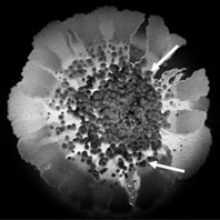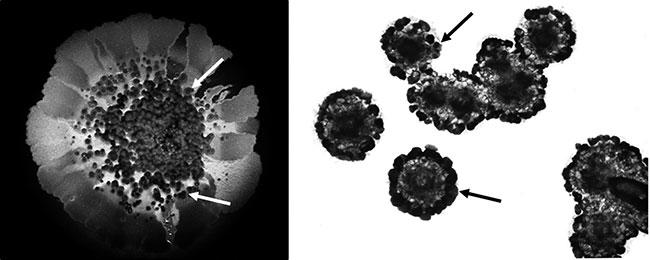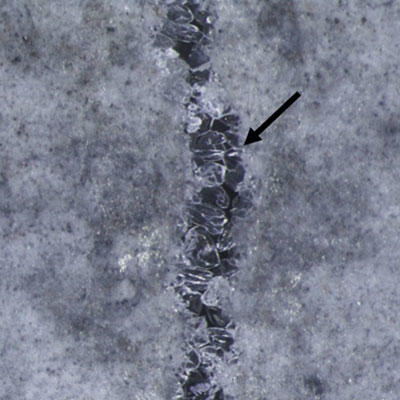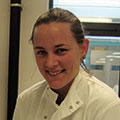Building bacterial bridges
Issue: Microbial Tools
15 May 2018 article

Microbes live all around us: in the soil we grow our food in, in the air we breathe, in the water we drink and even inside our bodies. These microbes are often thought of in a negative light, for example, as a causative agent of sickness and food spoilage. However, the reality is that microbes are essential for life and play key roles in the ecology of natural environments, as well as in many biotechnological applications.
Indeed, it is becoming the norm to exploit bacteria in industrial processes for their ability to act as ‘cell factories’ that can produce important speciality products such as detergents, plastics, fuels and essential oils. Apart from the production of important compounds, they are also useful in the breakdown of environmental contaminants such as pesticides, petroleum additives and plasticisers. The successful use of bacteria on the industrial scale has prompted expansion into more diverse areas. A recent addition to the résumé of these tiny organisms is the utilisation of biomineralising bacteria in self-healing construction materials.
Constructive bacteria
Often, the first things that come to mind when we think about microbes in the built environment are damage, decay, discolouration and staining to building materials and their surfaces. What we don’t consider is their ability to act as ‘bioengineers’. This is despite the fact that microbes are often involved in important natural processes such as sediment formation in marine and freshwater environments, as well as stalactite and stalagmite formation in caves. In geotechnical applications, bacteria are now being used as part of the engineering ‘toolbox’ for the consolidation and stabilisation of soils to counteract erosion, enhance bearing capacity, and enable excavation and tunnelling. This is due to the intrinsic ability of a wide range of bacteria to promote the precipitation of mineral carbonate, such as calcium carbonate, as a by-product of their metabolism. Several core metabolic processes in the bacteria lead to an increase in the pH and concentration of carbonate in the surrounding microenvironment. This in turn causes supersaturation and thus precipitation of the carbonates as minerals, for example as calcite.
Calcite crystals on bacterial colonies. Bar, 1 mm. B. Reeksting

The precipitates decrease the pore space in the soil and act as a glue that binds together soil particles, leading to densification. In addition to changing the pH, the presence of bacterial cells can directly aid the precipitation of carbonate minerals. This is because bacterial cell surfaces are usually negatively charged, which attracts positively charged calcium ions and can act as a nucleation site for formation of calcite crystals. The successful use of microbes as soil improvement tools has led researchers to explore whether these bioengineers could also be useful in the construction industry.
Bacillus buildings
The application of bacterial biomineralisation is an attractive idea in prolonging the lifetime of cement-based materials, e.g. concrete, and structures such as buildings, bridges and tunnels. Over time, weathering and tensile stresses contribute to the progressive decay of concrete due to the formation of micro-cracks. These micro-cracks allow ingress of water, along with harmful ions such as chlorides that may trigger corrosion of the internal steel reinforcement and sulfates that can attack the internal structure of the concrete itself.
Calcite crystal (left; bar 50 μm) and imprints of bacteria in calcite (right; bar 1 μm). B. Reeksting.

The enormity of this problem is evidenced by the large cost of repair and maintenance in the UK construction industry, which is estimated as nearly £50 billion per year. Aside from cost, concrete production contributes up to 7% of global anthropogenic carbon dioxide emissions, emphasising the need for lower-maintenance and longer-lifespan products. The possibility of self-healing concrete that can automatically seal up any micro-cracks is therefore highly appealing. Not only would this reduce repair costs, but it would also negate the need for many new structures. How then do we use these bacterial engineers to improve concrete?
Concrete poses a harsh alkaline environment (pH 9–12), so bacteria are needed that can survive and grow under such conditions. Members of the genus Bacillus and the related Sporosarcina are ubiquitous in nature, and are relatively robust in their resistance to harsh chemical and physical environments. They also have the added advantage that they can form spores to facilitate long-term survival. The concept of self-healing materials such as concrete is to include these bacteria during the mixing phase so that they are present within the final structure, but cannot immediately grow because of absence of nutrients. Once a crack develops in the concrete, the bacteria gain access to water and nutrients via this crack and start growing. Their metabolism increases the local pH and the bacterial cell surfaces act as initiation sites for crystal growth. This triggers precipitation of calcite minerals and subsequent sealing of the crack. Calcium carbonate provides the ideal environmentally friendly filler for concrete, because it naturally forms within concrete during maturation and is therefore highly compatible with cementitious materials. Initial explorations have already shown that inclusion of bacteria can indeed improve the quality of cementitious construction materials.
Building the future
The usefulness of microbial biomineralisation in construction materials has been established in principle in the laboratory and in several field trials. However, several challenges still have to be overcome. For example, methods for optimising the survival of the bacteria within concrete are currently being developed.
Calcite crystal formation within cracked concrete. Bar 500 μm. University of Bath |

|
A promising approach is encapsulation, where the bacteria are protected within porous solids such as perlite or polymer-based microcapsules. These capsules are directly incorporated into the concrete mix, and will only release the bacteria when a micro-crack forms and breaks the capsule. Another line of research is looking at the potential of bacteria to perform many cycles of healing. This will entail bacteria germinating from their spores upon formation of the initial crack, inducing precipitation of calcite, and subsequently returning to spore form to await the formation of further cracks. A final challenge will be to upscale this process from the lab scale to being suitable for commercial use.
Self-healing concrete technology would be ideal in the construction of difficult-to-access structures such as tunnels, bridges and underground drainage pipes, which are exposed to constant tensile and weathering stresses, and are difficult and costly to repair and maintain. Although room for improvement remains, current research into such self-healing biomaterials is intense and promising. Ultimately, this approach will allow us to build bacterial bridges towards a brighter, more sustainable future.
The authors are members of the EPSRC-funded Resilient Materials for Life (RM4L) project (Twitter: @Materials4Life), where they work with colleagues from the Universities of Cardiff, Cambridge and Bradford to develop self-diagnosing, self-healing construction materials.

Timothy Hoffmann
Department of Biology & Biochemistry, University of Bath, Bath BA2 7AY
Timothy Hoffmann is a PhD student at the University of Bath in the Department of Biology and Biochemistry. His research focuses on areas of synthetic biology and metabolic engineering of micro-organisms for application towards self-healing concrete technologies. Timothy has been a member of the Microbiology Society since 2017.

Bianca Reeksting
Department of Biology & Biochemistry, University of Bath, Bath BA2 7AY
[email protected]
Twitter: @bjreeksting
Bianca Reeksting is a Research Associate in the Department of Biology and Biochemistry at the University of Bath. Her research focuses on the selection and characterisation of bacteria for industrial application, such as for the incorporation into concrete for self-healing. She has been a member of the Microbiology Society since 2017.

Richard Cooper
Department of Biology & Biochemistry, University of Bath, Bath BA2 7AY
Richard Cooper is a Reader in Plant–Micro-organism Interactions at the University of Bath. His research investigates the mechanisms by which microbes can cause disease and how this knowledge can be applied to disease control. He is also interested in how micro-organisms can be applied in other contexts, such as self-healing building materials.

Kevin Paine
BRE Centre for Innovative Construction Materials, Department of Architecture and Civil Engineering, University of Bath, Bath BA2 7AY
[email protected]
Twitter: @kevpaine
Kevin Paine is a Reader in Civil Engineering and Deputy Director of the BRE Centre for Innovative Construction Materials at the University of Bath. He carries out research in the area of smart and innovative concrete technology, and in particular the development of self-healing, self-sensing and self-diagnosing concretes.

Susanne Gebhard
Milner Centre for Evolution, Department of Biology & Biochemistry, University of Bath, Bath BA2 7AY
[email protected]
Twitter: @GebhardLab
Susanne Gebhard is a Senior Lecturer in Medical Microbiology at the University of Bath. Her research interests focus on how bacteria respond to hostile conditions in their environments, such as antibiotics, but also how particularly stress-tolerant bacteria can be applied in an industrial setting. She is a member of the Microbiology Society, having joined in 2014.
What is the best career decision you have ever made?
Susanne: Not giving up on pursuing an academic career.
What parts of your job do you find most challenging?
Susanne: Managing my time between all the different duties as a lecturer (teaching, research and admin) to do a good job with all of them, while still trying to be a good colleague and supportive supervisor.
